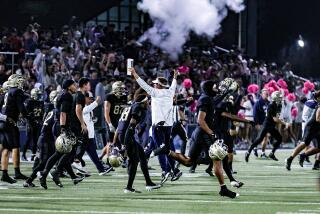Trade School in Rosemead Says the Key Is Computers
ROSEMEAD â More than a century and a half after St. John Bosco founded Italyâs first Catholic trade school for boys in 1835, the school here that bears his name is training young men to master computers before facing the job market.
The 33-year-old, 1,000-student Don Bosco Technical Institute will dedicate a new computer center Thursday. Funded by a $123,500 grant from the Ralph M. Parsons Foundation in Los Angeles and an additional $62,000 in donations, the project brings computers closer to the classroom. The final goal is within eight years to provide every student with access from home to tutorials and electronic mail on campus.
âWhen I was going to high school, the slide rule was the big thing, then it was hand-held calculators,â said Father Nick Reina, the schoolâs president. âWhat we are trying to do is get students familiar with computers, so when they get out in the field they can (immediately) use it as a tool.â
Hours of Schooling
In addition to completing a college preparatory academic curriculum, Bosco Tech students devote two hours daily to one of seven technological majors, including electronics and computer, automotive, graphic communications, drafting and manufacturing.
Thatâs not all. Two hours of homework are customarily assigned each day.
Although about half the students choose to graduate after four years with a technical high school diploma, others stay another year to obtain a junior college associate in science degree in their chosen technology.
Parsons Foundation Executive Director Christine Sisley praised the school as exemplary in combining excellence in academics and technical training. Last year all 83 of Bosco Techâs high school graduates were accepted by universities--20 by UC Berkeley--and all 113 of its fifth-year graduates received college acceptances or job offers.
The foundation offers grants to nonprofit organizations and educational institutions in various fields. The large proportion of minorities in Don Boscoâs student population--70% are Latino and 15% Asian--is another reason it won the award, Sisley said.
With the new computer lab, all freshmen and sophomores will study computer literacy, said associate director of development Lois Maldonado. Previously, except for computer science majors, most students didnât learn on computers until their junior year, she said.
40 Computer Terminals
The lab is equipped with 40 new terminals that have high-resolution color monitors and memories to run word-processing, database and spreadsheet programs. The computers can also operate computer-aided drafting programs.
In traditional drafting, students have to draw by hand three views, the front, side and top, of a machine component. But with computers, the trainee uses a âmouseâ to sketch just its top and front profiles on the screen; the system then renders a three-dimensional view.
The school is raising money for another 25 to 30 of these 3-D computers for a second lab.
âThere is so much you can do in terms of how you visualize an objectâ with the new equipment, said Bob Traulsen, chairman of the drafting and design department. âYou can rotate it, look at it from different angles, and when you find the combination of faces you want, you just ask for a printout. Once the boys learn the basics, they can be applied to any system.â
James Zamora, a senior in drafting and design, is thrilled about the advanced equipment âbecause itâs happening out in the field. . . .â
After graduation, âit wonât be that scary out there,â he said.
More to Read
Sign up for Essential California
The most important California stories and recommendations in your inbox every morning.
You may occasionally receive promotional content from the Los Angeles Times.










